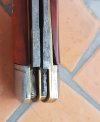meako
Gold Member
- Joined
- Sep 4, 2006
- Messages
- 10,081
Cue violin music.
This is beginning to worry me.
I bought this as a Xmas present for myself. I have been seriously abandoned by my family which has me in pain and financial turmoil.
Selfishly wanting something to open on xmas morning apart from a vein I left it in its package til then.
I love the orange burl scales and lge stockman pattern. Its been my precious ever since. That plus its a Queen S&M so its like may not be seen again.Loving the patina it has grown.
Now this
Warp factor 5.
Thinking supaglue and a clamp before it gets worse. But dammit Jim I'm a retired fireman not a cutler! Nor do I have access to any of my tools ,knives, and most other equipment nor possessions.
Seems lady luck has left meako at the pound.
Any clues for a fix on this most welcome and thanks in advance.
This is beginning to worry me.
I bought this as a Xmas present for myself. I have been seriously abandoned by my family which has me in pain and financial turmoil.
Selfishly wanting something to open on xmas morning apart from a vein I left it in its package til then.
I love the orange burl scales and lge stockman pattern. Its been my precious ever since. That plus its a Queen S&M so its like may not be seen again.Loving the patina it has grown.
Now this

Warp factor 5.
Thinking supaglue and a clamp before it gets worse. But dammit Jim I'm a retired fireman not a cutler! Nor do I have access to any of my tools ,knives, and most other equipment nor possessions.
Seems lady luck has left meako at the pound.
Any clues for a fix on this most welcome and thanks in advance.
